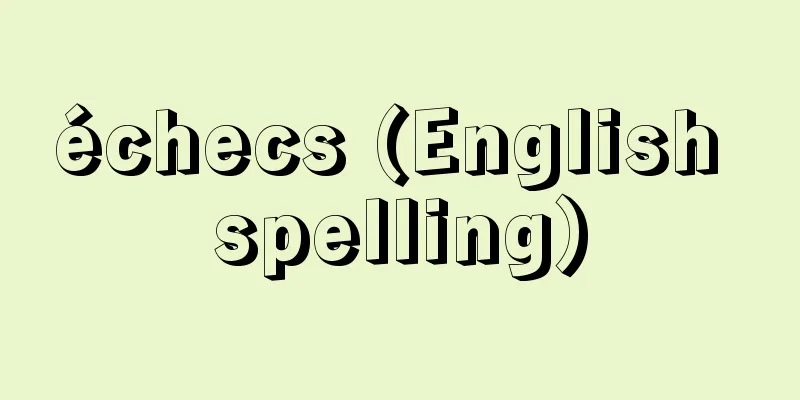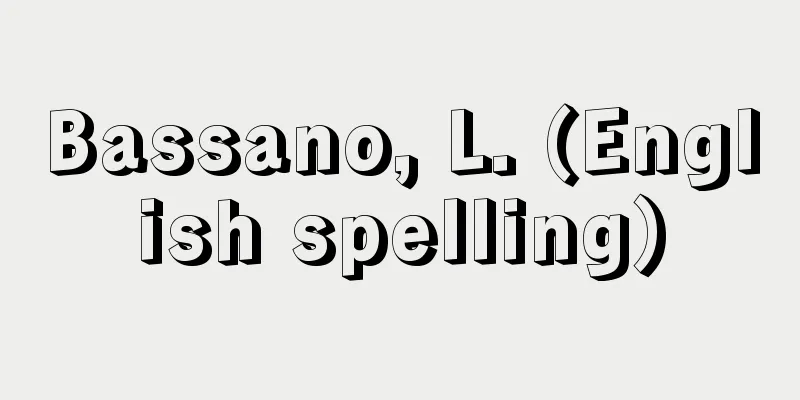Nursery school - Hoikusho

|
This refers to child welfare facilities based on the Child Welfare Act (Act No. 164 of 1947) and education and childcare facilities based on the Child and Childcare Support Act (Act No. 65 of 2012). Matters concerning the content of childcare at childcare centers and related matters concerning their operation are stipulated in the "Childcare Center Childcare Guidelines." [Mariko Miyata and Kiyomi Akita April 18, 2018] The purpose of the nursery schoolA nursery school is a facility that aims to care for children whose guardians are unable to care for them at home because they are working, sick, providing care for a family member, pregnant, or have just given birth. It is defined as a child welfare facility in Article 7 of the Child Welfare Act, and Article 39 of the same act states that it is a facility that aims to care for infants and young children who need care by sending them to the facility every day from their guardians (limited to facilities with a capacity of 20 or more, excluding certified childcare centers that combine early childhood education and care). Children are not admitted unconditionally, but if there is room, it does not prevent private contract children from using the facility. In addition, Article 7, paragraph 4 of the Child and Childcare Support Act states that it is an "educational and childcare facility" as "a nursery school as defined in Article 39, paragraph 1 of the Child Welfare Act (excluding those certified under Article 3, paragraph 1 of the Certified Childcare Center Act and those publicly notified under the provisions of Article 9 of the Certified Childcare Center Act)." [Mariko Miyata and Kiyomi Akita April 18, 2018] The role of nursery schoolsArticle 1 of the Child Welfare Law states that all children "have the right to be properly raised, to have their lives guaranteed, to be loved and protected, to have their healthy growth and development in mind and body, and to have their independence promoted, and to have other welfare rights guaranteed equally." Furthermore, Article 2, paragraph 3 states that "The state and local public entities, together with the guardians of children, are responsible for raising children in a healthy state in mind and body." Nursery schools are facilities stipulated in the law, and are institutionalized under the principle of ensuring the welfare of children and the responsibility for raising them. Article 1 of the Child and Child-rearing Support Law also states that "In light of the rapid decline in the birthrate in Japan and the changes in the environment surrounding families and communities, this law aims to provide necessary support for children and those who are raising children, as well as child and child-rearing support benefits, in conjunction with measures under the Child Welfare Law and other laws related to children, thereby contributing to the realization of a society in which each and every child can grow up healthy," and nursery schools are expected to play a part in the "quantitative expansion and qualitative improvement" that has been an issue in the childcare system in recent years. [Mariko Miyata and Kiyomi Akita April 18, 2018] Installation, Facilities and OperationTo establish a nursery school, municipalities must notify the prefectural governor, and other parties must obtain approval from the prefectural governor (including mayors of designated cities and core cities) (Child Welfare Law, Article 35, Paragraphs 3 and 4). Based on the provisions of Article 45, paragraph 1 of the Child Welfare Law, the minimum standards for the facilities and operation of child welfare facilities are established by a Ministry of Health, Labor and Welfare ordinance, and the facilities and operation of daycare centers must also conform to the standards set by prefectures based on these standards. These standards include facility equipment, staff allocation (childcare workers, cooks, contracted doctors), number of infants per child, and the principle of childcare hours (8 hours per day). Licensed facilities are required to always comply with the above standards and are subject to regular guidance and supervision (Article 46 of the Child Welfare Law). If they are not complied with, they may be subject to measures such as recommendations or orders for improvement, suspension of business (Article 46, paragraphs 3 and 4 of the Child Welfare Law), and revocation of the facility establishment license (Article 58 of the Child Welfare Law). [Mariko Miyata and Kiyomi Akita April 18, 2018] Nursery teacherThe term "childcare worker" was added on April 1, 1999 (Heisei 11) to replace the previous title "hobo", and is stipulated in the Child Welfare Law. The law stipulates that a person with a childcare worker qualification must be registered (Child Welfare Law, Article 18-18, Paragraph 1), and that a "childcare worker" is "a person who, using the title of childcare worker and with specialized knowledge and skills, provides childcare and guidance to the guardians of children regarding childcare" (Child Welfare Law, Article 18-4). A childcare worker qualification can be obtained by either graduating from a designated childcare worker training facility or by passing a childcare worker examination administered by the prefectural governor. In recent years, the concurrent holding of a kindergarten teacher license has been promoted, and those who have a kindergarten teacher license are exempt from some of the credits that need to be acquired. In addition, the "Law Partially Amending the National Strategic Special Zone Law and the Structural Reform Special Zone Law" has started a system of childcare workers limited to national strategic special zones (regionally limited childcare workers), and in addition to the childcare worker examination administered by the prefectural governor, a childcare worker can also obtain the qualification by taking the regionally limited childcare worker examination administered by the local government of the national strategic special zone. However, there are employment conditions for this qualification, and employment is limited to National Strategic Special Zones for the three years after obtaining the qualification, after which they can work anywhere in the country. [Mariko Miyata and Kiyomi Akita April 18, 2018] Origin and evolutionThe first daycare facility is said to have been started by Johann Friedrich Oberlin (1740-1826) in France in 1779. Later, there were others such as the Character Formation Institute founded by Robert Owen in England in 1816. The establishment of each facility was related to the needs of the local community and working mothers. In Japan, the oldest daycare facility was the Niigata Seishu Gakko, founded in 1890 (Meiji 23) by Akazawa Atsumi (1864-1937) and his wife Nakako. It is said to have started as a separate room to look after preschool children to help babysit students who attended the school. Later, daycare facilities were opened at the Dai-Nippon Boseki Co., Ltd. (current Unitika) factory in Tokyo in 1894 and at the Miike Coal Mine in Fukuoka in 1896. In the Meiji period, there were practices such as Futaba Kindergarten, which aimed to support poor children in urban areas, and in the Taisho period, public facilities were established in Osaka, Kyoto, Tokyo, etc. to support low-income workers, and daycare centers were also established in various places during the busy farming season. After that, they were positioned under the Japanese legal system as daycare businesses under the old Livelihood Protection Law (1946), and as nurseries with the enactment of the Child Welfare Law (1947). In the 1960s, the demand for childcare increased, and the creation of childcare centers spread with the cry of "we need as many childcare centers as there are job posts," and calls for the implementation of special childcare programs such as infant care and extended childcare hours also grew. In the 2000s, measures were taken to deal with the ever-increasing demand for childcare, including deregulation of childcare center establishment approvals and the formulation of the New Angel Plan, and various measures have been considered and implemented up to the present day, such as the Child and Childcare Support Act (2012). [Mariko Miyata and Kiyomi Akita April 18, 2018] assignmentAs a type of child welfare facility, daycare centers have responded to childcare needs by implementing special measures and related policies. Special measures include infant care that allows use from the age of 0, extended childcare and holiday childcare programs that accommodate the diverse working hours of parents, and local childcare support centers that can prevent child abuse caused by isolation in childcare due to the trend toward nuclear families. Other daycare center-related policies include in-house daycare centers set up by employers for their employees, and childcare support activity support programs (Family Support Center programs) that communicate and coordinate between those who wish to help look after infants and elementary school children and those who wish to provide the support. Another notable issue in recent years is the elimination of children on waiting lists. Children on waiting lists are infants and young children who need childcare and have applied for admission, but are unable to use appropriate childcare services. This situation became an issue during the second baby boom in the 1960s and 1970s and in the 1990s, especially in urban areas, and continues to this day. To address this issue, the Ministry of Health, Labor and Welfare is working to strengthen acceptance by supporting childcare services independently provided by local governments, to secure human resources through career training and the promotion of ICT, and to meet the supply needs of new childcare businesses such as corporate-led childcare businesses. In addition, in order to "quantitatively expand and improve quality," including measures to address the issue of children on waiting lists, three laws related to children and childcare were enacted (2012), and a new childcare and childcare support system based on these laws was launched in fiscal 2015 (Heisei 27). [Mariko Miyata and Kiyomi Akita April 18, 2018] "Childcare Center Management Handbook" edited by Chuohoki Publishing (2016, Chuohoki Publishing)" ▽ "National Childcare Organization Liaison Committee/Childcare Research Institute "Childcare White Paper 2017" (2017, Hitonarushobo)" [References] | | | | | |Source: Shogakukan Encyclopedia Nipponica About Encyclopedia Nipponica Information | Legend |
|
児童福祉法(昭和22年法律第164号)に基づく児童福祉施設、および子ども・子育て支援法(平成24年法律第65号)に基づく教育・保育施設のこと。保育所における保育の内容に関する事項およびこれに関連する運営に関する事項については、『保育所保育指針』に定められている。 [宮田まり子・秋田喜代美 2018年4月18日] 保育所の目的保育所は、保護者が「働いている」「病気の状態にある」「介護を行っている」「妊娠中かあるいは出産後間もない」などのために、家庭での保育が十分に行えない状態にある児童を保育することを目的とする施設である。児童福祉法第7条において児童福祉施設として規定され、同法第39条において「保育を必要とする乳児・幼児を日々保護者の下から通わせて保育を行うことを目的とする施設(利用定員が20人以上であるものに限り、幼保連携型認定こども園を除く)とする」と定められている。児童の入所は無条件ではないが、定員に余裕のある場合は、私的契約児の利用は妨げないとされている。また子ども・子育て支援法では、第7条第4項において「児童福祉法第39条第1項に規定する保育所(認定こども園法第3条第1項の認定を受けたもの及び同条第9項の規定による公示がされたものを除く)」とあり、「教育・保育施設」として定義されている。 [宮田まり子・秋田喜代美 2018年4月18日] 保育所の役割児童福祉法第1条に、すべての児童は「適切に養育されること、その生活を保障されること、愛され、保護されること、その心身の健やかな成長及び発達並びにその自立が図られることその他の福祉を等しく保障される権利を有する」とある。さらに第2条3項では「国及び地方公共団体は、児童の保護者とともに、児童を心身ともに健やかに育成する責任を負う」とされている。保育所は同法に規定された施設であり、上記児童の福祉を保障する原理と育成の責任において制度化されている。また子ども・子育て支援法の第1条は「この法律は、我が国における急速な少子化の進行並びに家庭及び地域を取り巻く環境の変化に鑑み、児童福祉法その他の子どもに関する法律による施策と相まって、子ども・子育て支援給付その他の子ども及び子どもを養育している者に必要な支援を行い、もって一人一人の子どもが健やかに成長することができる社会の実現に寄与することを目的とする」とあり、保育所には、近年の保育制度の課題である「量的拡充と質的改善」に対し一翼を担う施設としての期待もある。 [宮田まり子・秋田喜代美 2018年4月18日] 設置・設備と運営保育所の設置は、市町村は都道府県知事に届け出、その他の者は都道府県知事(指定都市・中核市市長を含む)の認可を得なければならない(児童福祉法第35条第3項、第4項)。 児童福祉施設の設備と運営については、児童福祉法第45条第1項の規定に基づいて、児童福祉施設の設備および運営に関する最低基準が厚生労働省令をもって制定されており、保育所の設備と運営も、この基準を基礎として都道府県が定めた基準に適する必要がある。この基準には、施設設備、職員の配置(保育士、調理員、嘱託医)および乳幼児一人当りの人数、保育時間の原則(1日8時間)などがある。認可施設においては、上記基準を常時遵守することが求められており、定期的な指導監督があり(児童福祉法第46条)、遵守されていない場合は改善勧告や改善命令、事業の停止(児童福祉法第46条第3項、第4項)、施設設置認可の取消等の処分がある(児童福祉法第58条)。 [宮田まり子・秋田喜代美 2018年4月18日] 保育士「保育士」は、1999年(平成11)4月1日にそれまでの名称であった「保母」に変わってつけられた資格名称であり、その規定は児童福祉法にある。同法では、保育士資格をもつ者が登録を受け(児童福祉法第18条の18第1項)、「保育士の名称を用いて、専門的知識及び技術をもつて、児童の保育及び児童の保護者に対する保育に関する指導を行うことを業とする者」(児童福祉法第18条の4)と定められている。保育士資格は、指定保育士養成施設を卒業するか、あるいは都道府県知事実施による保育士試験に合格するかのいずれかによって取得することができる。近年では、幼稚園教諭免許との併有化が促進され、幼稚園教諭免許取得者は修得が必要な単位の一部が免除される。また、「国家戦略特別区域法及び構造改革特別区域法の一部を改正する法律」により、国家戦略特別区域限定保育士(地域限定保育士)制度が開始され、都道府県知事が行う保育士試験とは別に、国家戦略特別区域の自治体が実施する地域限定保育士試験を受験して資格を取得することもできる。ただしこの資格には就労に関する条件があり、資格取得後3年間の就労は国家戦略特別区内限定であり、その後に全国で働くことができるものになっている。 [宮田まり子・秋田喜代美 2018年4月18日] 起源と変遷託児施設は、ヨハン・フリードリヒ・オーベルランJohann Friedrich Oberlin(1740―1826)が1779年にフランスで始めたものが最初であるとされている。その後は1816年にロバート・オーエンがイギリスで設立した性格形成学院などがある。いずれの施設の設立も、地域のニーズや就労する母親のニーズと関係している。 日本では、1890年(明治23)に赤沢鍾美(あかざわあつとみ)(1864―1937)、仲子夫妻による「新潟静修学校」が最古の託児施設とされており、学校に通う生徒の子守を助けるため、別室において就学前の子どもたちの世話を行ったことが始まりとされている。その後1894年に東京の大日本紡績株式会社(現、ユニチカ)の工場や、1896年に福岡の三池(みいけ)炭鉱で託児施設が開設された。明治期ではおもに都市部における貧困児童への支援を目的とした二葉(ふたば)幼稚園などの実践があり、大正期では低所得勤労者への支援として大阪市、京都市、東京市等に公立施設が設置され、また各地で農繁期託児所などが設置されるなどしている。その後は旧生活保護法(1946)における託児事業として、そして児童福祉法の制定(1947)により保育所として、日本の法制度の下に位置づけられている。 1960年代に入り、保育需要は高まり「ポストの数ほど保育所を」と叫ばれて保育所づくりが広がり、乳児保育や延長保育等の特別保育事業の実施を求める声も高まった。2000年代に入り、少子高齢化対策においては、保育所設置認可に関する規制緩和や新エンゼルプランの策定に際し、増加し続ける保育需要によって出現し続ける待機児童に対する対策がとられ、以後今日まで子ども・子育て支援法(2012)などさまざまな対策が検討され実施されている。 [宮田まり子・秋田喜代美 2018年4月18日] 課題保育所は、児童福祉施設の一つとして、保育ニーズに対し、特別な対策と関連施策を実施することによる対応を図ってきた。特別な対策には、0歳児からの利用を可能にした乳児保育、保護者の多様な労働時間に応える延長保育や休日保育事業、核家族化などによる子育ての孤立化による児童虐待などの予防になり得る地域子育て支援拠点事業などがある。また保育所関連の施策としては、事業主が従事者のために設置する事業所内保育所や、乳幼児や小学生の預かり援助を希望する者と援助を行うことを希望する者との連絡・調整を行う子育て援助活動支援事業(ファミリー・サポート・センター事業)などがある。 また特記すべき近年の課題は、待機児童の解消である。待機児童とは、保育を必要とし、入所の申請をしているにもかかわらず、適当な保育サービスを利用することができない乳児や幼児のことであり、1960~1970年代にあった第二次ベビーブーム時と1990年代の、とくに都市部においてその実態が問題となり今日まで続く課題となっている。厚生労働省は待機児童解消に向け、自治体が独自に支援する保育サービスを支援するなどの受け入れの強化、キャリアアップ研修やICT化の推進などによる人材確保に関する取り組み、企業主導型保育事業などの新規保育事業による供給の充足等の取り組みを行っている。またこれら待機児童対策も含めた「量的拡充と質的改善」のためとして、子ども・子育て関連三法の成立(2012)およびそれに基づく子ども・子育て支援新制度が2015年度(平成27)から開始されている。 [宮田まり子・秋田喜代美 2018年4月18日] 『中央法規出版編『保育所運営ハンドブック』(2016・中央法規出版)』▽『全国保育団体連絡会・保育研究所『保育白書2017』(2017・ひとなる書房)』 [参照項目] | | | | | |出典 小学館 日本大百科全書(ニッポニカ)日本大百科全書(ニッポニカ)について 情報 | 凡例 |
Recommend
Stankoviĉ, K.
...A country that existed in the western Balkan P...
Mine [town] - Mine
A former town in Miyaki County in eastern Saga Pre...
organum
...The Abbey of Saint-Martial near Limoges in cen...
mediolittoral zone
…Depending on the tidal action, seven tidal level...
Watchtower - Kan
…The most popular theory is that the name Que was...
Front - Front
…In terms of operation, there are regular routes ...
Orkhon [river] - Orkhon
A river in Mongolia. It originates in the Khangai ...
Kin selection
Also known as kin selection. This refers to the na...
nevus
…A red, blue, or brown spot on the skin. It can r...
André Malraux
French novelist and thinker. Born in Paris on Nov...
Kyoko - Kyoko
…The Jialing River became navigable as far as Sha...
Tavernier, JB (English spelling)
...The Hope (about 44 carats), purchased by Louis...
Kanemi Oil Shokujiken - Kanemi Oil Shokujiken
This was a food poisoning incident that caused a l...
Camus, E.L. - Camyu
...also called gears. A type of mechanical part t...
Gengenshu - Gengenshu
A medieval Shinto book. Eight volumes. It is said ...









